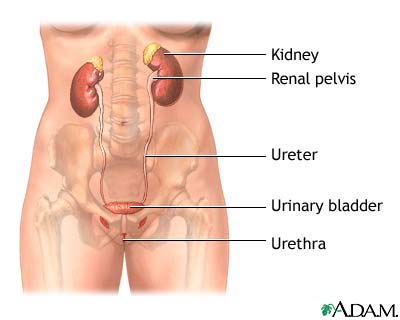Treatment
Antibiotics such as ampicillin or Bactrim are usually given to prevent further infections until surgery can be done.
The goal of treatment is to get rid of the blockage. Drains placed in the ureter or renal area (stents) may provide short-term relief of symptoms.
Surgery to repair the ureterocele usually cures the condition. Surgery involves making a cut into the ureterocele (“popping the water balloon”) or removing the ureterocele and reattaching the ureter to the bladder. Which surgery is performed depends on the severity of the blockage.
Prognosis (Expectations)
The outcome varies. If the obstruction can be cured, the damage may be temporary. However, damage to the kidney may be permanent, especially if the condition doesn’t go away.
Kidney failure is uncommon because the other kidney usually continues to work as normal.
Complications
- Permanent bladder damage (incontinence/urinary retention)
- Permanent kidney damage, with a decrease or loss of function (one kidney)
- Urinary tract infection that keeps coming back
Calling Your Health Care Provider
Call your health care provider if you have symptoms of ureterocele.
Pictures & Images
Female urinary tract
-
Ureterocele: Overview, Causes
-
Ureterocele: Symptoms & Signs, Diagnosis & Tests
Ureterocele: Treatment
Review Date : 9/7/2008
Reviewed By : David C. Dugdale, III, MD, Professor of Medicine, Division of General Medicine, Department of Medicine, University of Washington School of Medicine; and Louis S. Liou, MD, PhD, Assistant Professor of Urology, Department of Surgery, Boston University School of Medicine. Also reviewed by David Zieve, MD, MHA, Medical Director, A.D.A.M., Inc.
